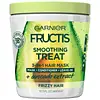Shiseido Fino Premium Touch Hair Mask Versus Garnier Fructis 1 Minute Nourishing Hair Mask + Avocado Extract
What's inside
What's inside
 Key Ingredients
Key Ingredients

 Benefits
Benefits

 Concerns
Concerns

 Ingredients Side-by-side
Ingredients Side-by-side

Hydrogenated Polyisobutene
EmollientC13-14 Isoparaffin
EmollientDimethiconol
EmollientIsopropyl Myristate
EmollientIsododecane
EmollientPolysilicone-13
Parfum
MaskingSqualane
EmollientPhytosteryl/Octyldodecyl Lauroyl Glutamate
Skin ConditioningLactic Acid
BufferingHydrolyzed Conchiolin Protein
Skin ConditioningDimethicone
EmollientTocopherol
AntioxidantWater
Skin ConditioningAmodimethicone
PPG-2-Deceth-12
EmulsifyingButylene Glycol
HumectantGlycerin
HumectantPhenoxyethanol
PreservativeHydrogenated Polyisobutene, C13-14 Isoparaffin, Dimethiconol, Isopropyl Myristate, Isododecane, Polysilicone-13, Parfum, Squalane, Phytosteryl/Octyldodecyl Lauroyl Glutamate, Lactic Acid, Hydrolyzed Conchiolin Protein, Dimethicone, Tocopherol, Water, Amodimethicone, PPG-2-Deceth-12, Butylene Glycol, Glycerin, Phenoxyethanol
Water
Skin ConditioningCetearyl Alcohol
EmollientGlycerin
HumectantIsopropyl Myristate
EmollientStearamidopropyl Dimethylamine
EmulsifyingButyrospermum Parkii Butter
Skin ConditioningOlea Europaea Fruit Oil
MaskingGlycine Soja Oil
EmollientSodium Hydroxide
BufferingRosmarinus Officinalis Leaf Extract
AntimicrobialCoco-Caprylate/Caprate
EmollientCocos Nucifera Oil
MaskingHydroxypropyl Guar Hydroxypropyltrimonium Chloride 2%
Citric Acid
BufferingTartaric Acid
BufferingCetyl Esters
EmollientCaramel
Cosmetic ColorantParfum 2%
MaskingWater, Cetearyl Alcohol, Glycerin, Isopropyl Myristate, Stearamidopropyl Dimethylamine, Butyrospermum Parkii Butter, Olea Europaea Fruit Oil, Glycine Soja Oil, Sodium Hydroxide, Rosmarinus Officinalis Leaf Extract, Coco-Caprylate/Caprate, Cocos Nucifera Oil, Hydroxypropyl Guar Hydroxypropyltrimonium Chloride 2%, Citric Acid, Tartaric Acid, Cetyl Esters, Caramel, Parfum 2%
 Reviews
Reviews

Ingredients Explained
These ingredients are found in both products.
Ingredients higher up in an ingredient list are typically present in a larger amount.
Glycerin is already naturally found in your skin. It helps moisturize and protect your skin.
A study from 2016 found glycerin to be more effective as a humectant than AHAs and hyaluronic acid.
As a humectant, it helps the skin stay hydrated by pulling moisture to your skin. The low molecular weight of glycerin allows it to pull moisture into the deeper layers of your skin.
Hydrated skin improves your skin barrier; Your skin barrier helps protect against irritants and bacteria.
Glycerin has also been found to have antimicrobial and antiviral properties. Due to these properties, glycerin is often used in wound and burn treatments.
In cosmetics, glycerin is usually derived from plants such as soybean or palm. However, it can also be sourced from animals, such as tallow or animal fat.
This ingredient is organic, colorless, odorless, and non-toxic.
Glycerin is the name for this ingredient in American English. British English uses Glycerol/Glycerine.
Learn more about GlycerinIsopropyl Myristate is an emollient, thickening agent, and texture enhancer. It is created from isopropyl alcohol and myristic acid.
It is used to help other ingredients be better absorbed. It is also an emollient and may help soften and hydrate the skin.
The comedogenic rating of this ingredient depends on the concentration. Lower amounts results in a lower rating.
Isopropyl Myristate may not be fungal acne safe. It can potentially worsen acne prone skin.
Learn more about Isopropyl MyristateParfum is a catch-all term for an ingredient or more that is used to give a scent to products.
Also called "fragrance", this ingredient can be a blend of hundreds of chemicals or plant oils. This means every product with "fragrance" or "parfum" in the ingredients list is a different mixture.
For instance, Habanolide is a proprietary trade name for a specific aroma chemical. When used as a fragrance ingredient in cosmetics, most aroma chemicals fall under the broad labeling category of “FRAGRANCE” or “PARFUM” according to EU and US regulations.
The term 'parfum' or 'fragrance' is not regulated in many countries. In many cases, it is up to the brand to define this term.
For instance, many brands choose to label themselves as "fragrance-free" because they are not using synthetic fragrances. However, their products may still contain ingredients such as essential oils that are considered a fragrance by INCI standards.
One example is Calendula flower extract. Calendula is an essential oil that still imparts a scent or 'fragrance'.
Depending on the blend, the ingredients in the mixture can cause allergies and sensitivities on the skin. Some ingredients that are known EU allergens include linalool and citronellol.
Parfum can also be used to mask or cover an unpleasant scent.
The bottom line is: not all fragrances/parfum/ingredients are created equally. If you are worried about fragrances, we recommend taking a closer look at an ingredient. And of course, we always recommend speaking with a professional.
Learn more about ParfumWater. It's the most common cosmetic ingredient of all. You'll usually see it at the top of ingredient lists, meaning that it makes up the largest part of the product.
So why is it so popular? Water most often acts as a solvent - this means that it helps dissolve other ingredients into the formulation.
You'll also recognize water as that liquid we all need to stay alive. If you see this, drink a glass of water. Stay hydrated!
Learn more about Water